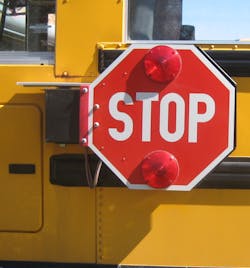In an effort to help improve overall safety results and improve safety culture at a large urban school bus location, the Durham School Services group turned to its sister transit division for some new ideas. While the school bus industry markets itself as the safest wheeled passenger vehicle mode of transportation in the nation with the lowest accident rates of any wheeled-vehicle mode, those results and numbers can be somewhat misleading. Much of the United States school bus service is performed in rural open areas and in suburbs where traffic tends to be less congested and the potential for having vehicle accidents is much lower than in large urban environments. Therefore, the miles between accidents are greater than those of public transit, which typically operates in congested city environments.
National Express’ Durham School Services has found that to be case with its larger urban school bus contracts. One of its contracts operating for the Philadelphia school system was just such a case in point. The overall accident frequency was much higher than most suburban school bus systems and higher than comparable National Express transit systems that are operated in similar urban environments.
New-Hire Bus Driver Training Enhancements
To turn around its safety performance in Philadelphia, Durham executives involved the National Express Transit Corp.'s transit division operations and safety management teams to improve the overall driving safety record. One of the first changes made after assessing the school bus driver training and overall training processes at the location was to increase the amount of new bus driver training time taught behind-the-wheel for the school bus drivers. Most school bus training programs are typically around 35 to 40 hours of total training time with approximately 15 to 20 hours of that time spent in the classroom, and the remaining 15 to 20 hours in behind-the-wheel instruction. In fact, an industry-leading bus driver training development course company owner was recently quoted in USA Today about how school bus drivers receive the least amount of training of any wheeled passenger transportation mode. Jeff Cassell, from the School Bus Safety Company in Hudson, Ohio, which puts together school bus and transit training programs for much of North America, said it is his company’s belief that the training should be extended to be more in alignment with what the transit industry requires.
Durham management felt that for the Philadelphia school bus location, with the city’s narrow streets and heavy traffic congestion, that its current 40-hour training program was not enough. So as a first improvement step, they doubled the amount of overall training time to 80 hours with a minimum of 40 hours per student behind-the-wheel. National Express’ transit division was already conducting a minimum of 120 hours of training for each transit location and was able to operate successfully in close-knit urban environments with wider and longer transit buses. Most transit agencies and most transit contractors across the nation conduct at least 100 hours of training for new-hire fixed-route bus operators.
The additional training time has allowed National Express and the Durham School Services Philadelphia location to spend more time with each student focusing on defensive driving and traversing the tight narrow streets of the urban Philadelphia environment. As typical in transit bus operator training, each Philadelphia school bus trainee student receives an additional 15 hours of line instruction training, which is driving the routes with a qualified existing driver after successfully completing the training course. So the line or route instruction is in addition to the 80 hours of extended school bus driver training. Many school bus driver training programs include their route or line instruction training as part of their total 15 to 20 hours of driving instruction.
A Transit Technology Tool for Driver Assessments
As another way to help improve the overall skills of the school bus drivers, the Durham School Services group decided it would utilize TrackIt Transit which offers driver assessments on board the vehicle and includes GPS mapping for transit on electronic tablets. While originally designed for transit applications, the TrackIt Transit program can work equally well with school buses. National Express’ transit division was already in the process of incorporating TrackIt in its transit contracts for a number of cities and urban environments. Each Safety Supervisor is provided with a ruggedized tablet with access to the TrackIt Software. This allows the supervisors to monitor the driver’s performance down to the specific route and within the TrackIt application provide the required documented response, reporting, observations and coaching. The TrackIt technology has allowed the Durham Philadelphia location to conduct better assessments and coaching to their school bus drivers. It also improves the efficiency of the assessment evaluation by eliminating the need for the supervisors to write out lengthy comments on hand-written forms because the TrackIt tablets have preloaded forms with the evaluation content already pre-populated into the form. Additionally, the TrackIt software has allowed the local management team to effectively evaluate their drivers’ skills needs and to decide what future training should be performed to improve the drivers’ skills.
By extending the new-hire school bus training time to be more in alignment with transit and by applying transit-derived technologies to urban school bus, better urban school bus safety performance is obtainable. The Durham School Services group is now considering the transit model of extended driving time in their other school bus operations. While fundamentally there is a cost of paying for more time needed to train the new bus drivers, it is the Philadelphia Durham location’s belief that the extended time offers a much better skilled driver to provide safe transportation to the children who ride their buses. It also helps to mitigate and eliminate preventable accidents. Transit may not receive the positive exposure that school bus transportation gets by quoting their safety performance as the safest passenger vehicle mode in the nation, but public transit can speak to better trained drivers operating behind the wheel.
Tom Greufe is VP of Safety – Transit and Urban School Bus for National Express.




